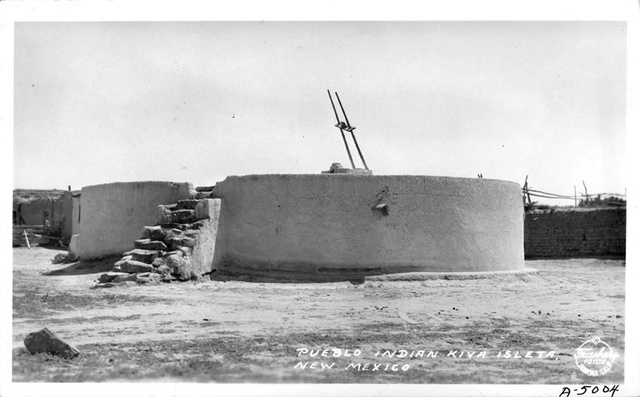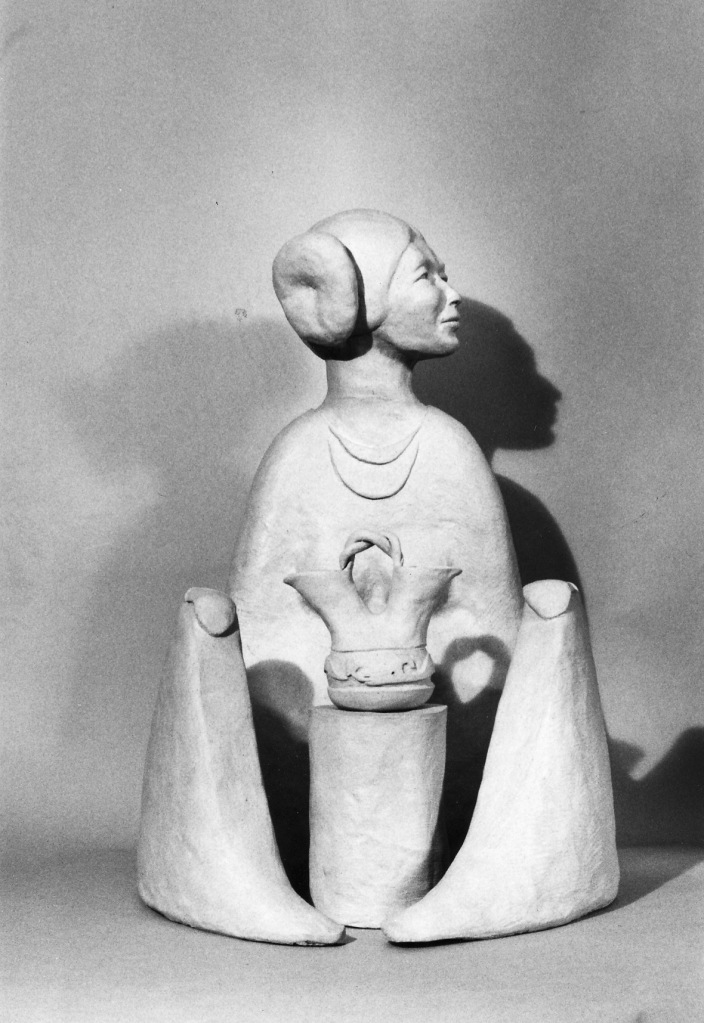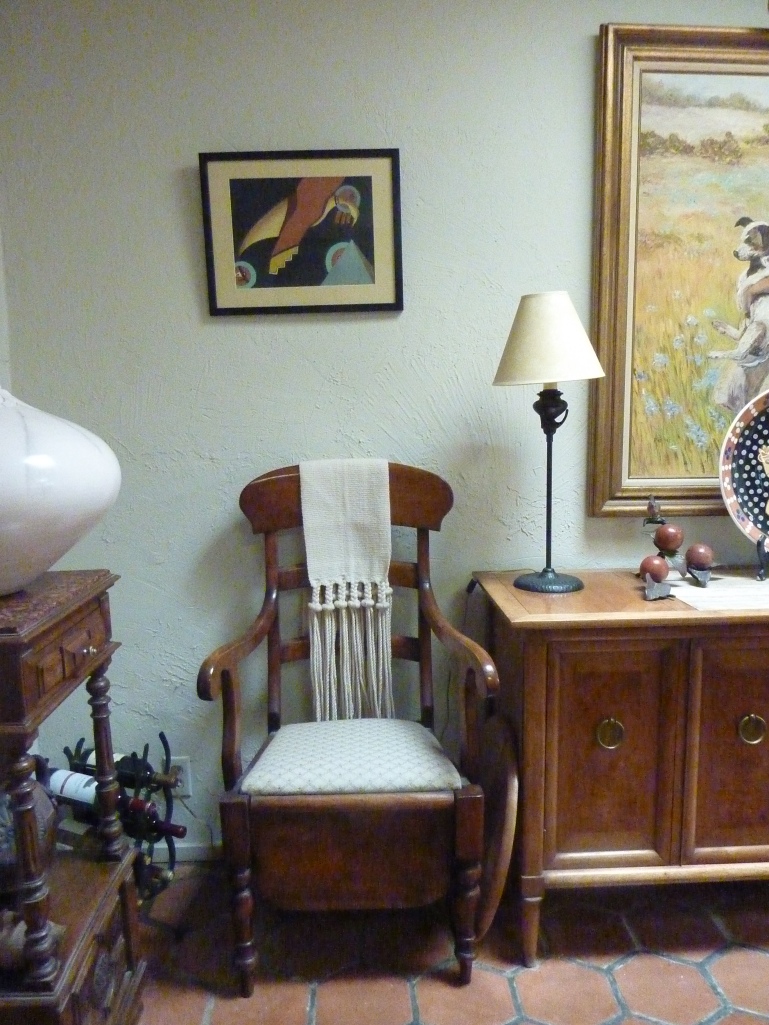“Hopi Bride With Wedding Pot” stoneware sculpture by kayti sweetland Rasmussen
Every bride is beautiful in her own way, and the Hopi bride of yesteryear was no exception. Though today’s bride is more apt to wear a long white wedding dress and serve a multi-layered wedding cake at her reception, not so long ago her preparations were time-consuming and laborious.
The two sided wedding vase was used by both the Cherokee and the Pueblo Indians and contained a sweet corn liquid which the bridal couple sipped during the ceremony.
After informing her mother and future mother-in-law of their intention to marry, the bride was set to the task of grinding corn for three days. Can you imagine a young woman of today grinding corn for three days?
The village beauty parlor then took over and after washing her hair with pounded yucca roots to make it shine, the bride’s mother cut the front hair to the level of her chin and rolled the long hair in back into two large coils over her ears which designated her new status as a married woman. After this ceremony, the bridal couple each took a pinch of cornmeal, walked to the eastern side of the mesa on which the village of Oraibi stands. Holding the meal to their lips they cast it to the wind and return to the house as husband and wife. Simple ceremony.
Gifts of corn were distributed around the village, and the bride set to work making dozens of paper breads for the festivities after the wedding to which the entire village was invited.

“Corn Maiden” stoneware sculpture by kayti sweetland rasmussen
 Kiva at Isleta, New Mexico, where I lived for some time in the 1960’s
Kiva at Isleta, New Mexico, where I lived for some time in the 1960’s
The crier of the village announces the time for the spinning of the cotton for the bride’s blanket which takes place in the kivas. The bridegroom and male members of his family then wove a large white blanket which would be used as the bride’s winding sheet upon her death, and a second smaller sash each with long tassels on the ends, plus a reed mat in which the blankets are to be rolled.
The last act of the drama is called “going home” in which the bride, who has been living with her husband’s people up to this time, returns to her family home. Wearing the large white blanket and carrying the smaller one wrapped in the reed mat she walks to her mother’s house. For in this land of women’s rights the husband must live with the his wife’s relatives.




Beautiful and intelligently sensitive work.
LikeLike
Thank you Carol Ann. It is a culture which is very important to me. A kind, frequently misunderstood people. I treasure my time with the Pueblo where after initial wariness they came to accept me and taught me many lessons of patience. Always willing to pose for me and listen to my “Anglo” babbling. In return, they taught me that one does not need to talk while enjoying a “quiet” friendship.
LikeLike
You are a wise and lovely human being.
LikeLike
What a sweet thing to say Carol Ann. Thank you.
LikeLike
Very nice and enjoyable with beautiful sculptures. It must have been a very interesting time getting to exchange friendships and learn each other’s cultures.
LikeLike
I consider myself very fortunate for all the years I was a welcome guest at their tables. I received an odd and discouraging reception when I came home filled with joy and excitement at my new-found enlightenment, when a member of my family was less than impressed. I learned that we are not all alike.
LikeLike
Well, my first reaction is that I am SO GLAD that a smaller sash (with the tassels) and not a large bride’s winding sheet is there on your chair. Whew.
I’m always struck by the silence of your sculpture. I especially like the feet. After reading this blog, I went back into my living room and studied the feet of a sculpture of yours that I bought in a local gallery JUST to have a Kayti Sweetland Rasmussen sculpture of my own.
Then you had to spoil it all by GIVING me a painting.
This post is informational, emotional, and spiritual. What a trifecta.
LikeLike
I couldn’t afford the winding sheet.
You will remember that we went to the Southwest every year for many years. The last time we went to old Taos to visit, the native cop at the gate was having a tizzy at a tourist woman who insisted on bringing her big video camera in without paying the $15. She completely ignored him and went on filming. I said it hadn’t changed at all during the years and he assured me it never would. I hope not.
LikeLike
No I can’t. Imagine a young woman today doing anything even REMOTELY like that. I wouldn’t, and I’m ancient ! [grin]
LikeLike
I liked the part where all they had to do was throw a couple of whiffs of cornmeal over the cliff and they were married. What a treat not to have had to write all those wedding vows!
LikeLike
Stringer and I went to the Registry Office. I couldn’t BEAR the thought of wasting money on a ‘real’ wedding: I’m one of those people who would infinitely prefer a washing-machine to an engagement ring. 🙂
LikeLike
I went for the ring!
LikeLiked by 1 person
Fascinating post, Kayti, with the photographs of kivas and young women with lovely shining hair in those amazing rolls, grinding corn. And your sculptures! What a talent you have.
LikeLike
Many years ago (too many) before I made my first trip to the Southwest, I made a small bust of an Indian woman to give to my Indian friend. I got the image from a photograph–front view only. She laughed her head off and said it looked like a “Dutch cut”. I said it was Navajo, and she showed me that the Navajo women wear
their back hair in a “chongo”, which is gathered in sort of a long bun. But I was quite flattered because she kept my little offering out and in plain sight.
It was she who first took me to New Mexico to visit her family and paint. We remained the closest of friends until she passed away some 40 years later. Her husband, a Quinalt from the North Coast, was my mentor for the people up the coast. He is now 100 years old and looking forward to the next “Paddle to Seattle” which he organized in 1989.
LikeLike
I have visited New Mexico and would love to spend more time there. How privileged you are to have had these longstanding friendships!
LikeLiked by 1 person
Interesting, that the newly-wedded couple returns to the bride’s family. I take it the culture is matriarchal, then? And the hair is beautiful. I remember now seeing such round “hoops” of hair in paintings, but I didn’t realize the significance. I wonder if pounded yucca would make my hair shine more? There’s some yucca about — maybe I should try it!
The Corn Maiden is beautiful. Has anyone ever pointed out to you how much the two of you resemble each other?
LikeLike
Basically the culture is matriarchal. A Navajo wife wanting her husband “out of there”, simply put his shoes and saddle outside the door of the hogan. Though the men moved into the wife’s family home, the mother-in-law was relegated to ride in the bed of the pick-up truck! I have seen many older women ensconced in a big chair in the back of the truck as they drove along.
You probably would never see the butterfly rolls in the girl’s hair now. I don’t really know how they got them that big, but undoubtedly with some kind of “rat”. I know at the village of Laguna they collected rainwater to wash their hair.
LikeLike
Brilliant post. I admire your Hopi maiden with her double-spouted vessel. Such strength and dignity in her face and posture. Very interesting to learn of the womens’ precedence. So much for all those rubbish determinists always going on about women and men. And the photograph of the women with their hair is amazing. I keep thinking about the chin-length hair … where does that go? And how do they do the rolls exactly? Are they stuffed with something? It’s quite like the Japanese geisha’s hair style too.
LikeLike
It may be thought of as matriarchal, but the women have a hard time of it. The problem of alcohol abuse is prevalent with all that entails.
Yes, the hair does remind one of the geisha’s hair style doesn’t it? The Navajo “do” is easier, they simply gather it up in a loose rolls in the back. I tried doing it when my own hair was long, but it wasn’t quite the same. I piled mine up on top.
I always liked the idea of the double-spouted vase. They said they used to drink some kind of corn liquor, but the drink of choice at most meals is Kook-Aid!
LikeLike
Very interesting. I love the serene expressions you have on your brides. I’m always surprised when I hear of girls, in other cultures, having the power to determine who they marry.
LikeLike
I can’t imagine having to live with someone you didn’t love. So many cultures connect families either socially or economically. It really make the whole thing a business arrangement suitable for supplying more children.
LikeLike